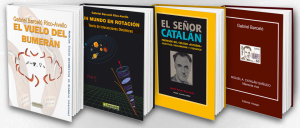An analysis of the dynamic behaviour of rotating bodies was carried out starting from certain indications and speculations relating to the movement of bodies with intrinsic rotation. As a result of such analysis, some hypothesis concerning the behaviour of bodies with intrinsic angular momentum were developed. And finally from those hypothesis, an alternative dynamic mathematical model was designed.
The starting hypothesis as well as the alternative mathematical model were confirmed by a series of experimental tests and also by a physical-mathematical simulation model of this behaviour.
Based on a reinterpretation of the behaviour of bodies with intrinsic angular momentum when submitted to successive torque’s, and according to the proposed hypothesis and the realized experimental tests, some general dynamic behaviour laws have been inferred.
These Rotational Dynamic Laws are based on the inertial impossibility of matter to change their dynamic state in certain cases and propose the concept of rotational inertia as an invariant of mass. These laws are understood as a negation of nature to selective and discriminating connection admitted until now, and allow to develop an alternative and specific Dynamic Interactions Theory for bodies with angular momentum.
By means of the generalization of the so-called “Gyroscopic Torque” as a dynamic interaction Torque, new and simple movement equations are obtained for bodies with intrinsic angular momentum when provoked by new non-coaxial torque’s. The simplicity of these new movement equations in Rotational Dynamics field is in clear contrast with the complexity of the various formulas used until now. The result is a simple mathematical formulation that can be defined by intrinsic coordinates without demanding an external Cartesian reference system.
The present text is only a short referential summary of the works carried out in order to propose a Rotational Dynamics of Interactions applicable to bodies submitted to multiple successive torque’s. The initial hypothesis’ have been confirmed by studies and experimental tests and by a mathematical model allowing the simulation of the real behaviour of bodies submitted to these excitations. Consequently we have been able to propose the existence of some general behaviour laws of rotational dynamics different to the ones of translation dynamics. A clear correlation between the initial speculations, the starting hypothesis, the mathematical simulation model, the deduced behaviour Laws, the realized experimental tests and the mathematical model corresponding to the movement equations resultant of the proposed dynamic laws have been obtained.
The proposed new dynamics allows to easily understand the effects of rotating bodies such as the interactions that occur when spinning a top, or a radial saw in movement or the behavior of so many rotating solids such as the boomerang, the stone skipped onto the water, balls with effect or the reason for the scratched core of cannons to give angular momentum to the projectiles.
The application of these dynamic hypothesis’ to astrophysics, atomic physics and to other fields of physics and technology possibly allows new and stimulating advances in investigation. The present document is a synopsis of the previous written texts related to the subject.
For more information about Theory of Dynamic Interactios, you can also visit Advanced Dynamics, S.A.


